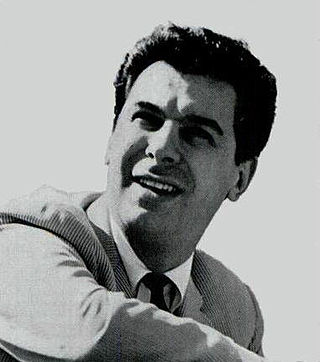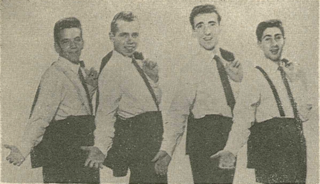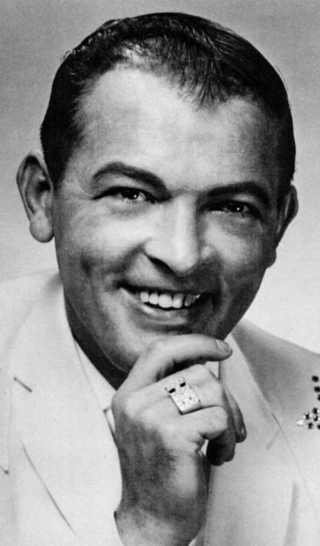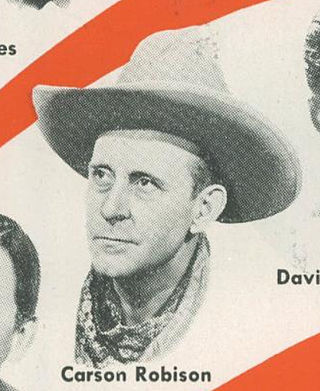Related Research Articles

William John Clifton Haley was an American rock and roll musician. He is credited by many with first popularizing this form of music in the early 1950s with his group Bill Haley & His Comets and million-selling hits such as "Rock Around the Clock", "See You Later, Alligator", "Shake, Rattle and Roll", "Rocket 88", "Skinny Minnie", and "Razzle Dazzle". Haley has sold over 60 million records worldwide. In 1987, he was posthumously inducted into the Rock and Roll Hall of Fame.
Rock and roll is a genre of popular music that evolved in the United States during the late 1940s and early 1950s. It originated from African American music such as jazz, rhythm and blues, boogie-woogie, electric blues, gospel, and jump blues, as well as country music. While rock and roll's formative elements can be heard in blues records from the 1920s and in country records of the 1930s, the genre did not acquire its name until 1954.

Richard Steven Valenzuela, better known by his stage name Ritchie Valens, was an American guitarist, singer and songwriter. A rock and roll pioneer and a forefather of the Chicano rock movement, Valens died in a plane crash just eight months after his breakthrough.

Doo-wop is a subgenre of rhythm and blues music that originated in African-American communities during the 1940s, mainly in the large cities of the United States, including New York, Philadelphia, Pittsburgh, Chicago, Baltimore, Newark, Detroit, Washington, D.C., and Los Angeles. It features vocal group harmony that carries an engaging melodic line to a simple beat with little or no instrumentation. Lyrics are simple, usually about love, sung by a lead vocal over background vocals, and often featuring, in the bridge, a melodramatically heartfelt recitative addressed to the beloved. Harmonic singing of nonsense syllables is a common characteristic of these songs. Gaining popularity in the 1950s, doo-wop was "artistically and commercially viable" until the early 1960s and continued to influence performers in other genres.

Fabian Anthony Forte, professionally known as Fabian, is an American singer and actor.

American Bandstand (AB) was an American music-performance and dance television program that aired regularly in various versions from 1952 to 1989. It was hosted from 1956 until its final season by Dick Clark, who also served as the program's producer. It featured teenagers dancing to Top 40 music introduced by Clark. The program was televised from Philadelphia from its 1952 debut until its move to Los Angeles in 1963

Harold "Chuck" Willis was an American blues, rhythm and blues, and rock and roll singer and songwriter. His biggest hits, "C. C. Rider" (1957) and "What Am I Living For" (1958), both reached No.1 on the Billboard R&B chart. He was known as The King of the Stroll for his performance of the 1950s dance the stroll.

Richard Wagstaff Clark was an American television and radio personality and television producer who hosted American Bandstand from 1956 to 1989. He also hosted five incarnations of the Pyramid game show from 1973 to 1988 and Dick Clark's New Year's Rockin' Eve, which broadcast New Year's Eve celebrations in New York City's Times Square.

The twist is a dance that was inspired by rock and roll music. From 1959 to the early sixties it became a worldwide dance craze, enjoying immense popularity while drawing controversies from critics who felt it was too provocative. It inspired dances such as the Jerk, the Pony, the Watusi, the Mashed Potato, the Monkey, and the Funky Chicken, but none was as popular.

Soul Train is an American musical variety television show. After airing locally on WCIU-TV in Chicago, Illinois, for a year, it aired in syndication from October 2, 1971, to March 25, 2006. Across its 35-year history, the show primarily featured performances by R&B, soul, and hip hop artists. The series was created by Don Cornelius, who also served as its first and longest-serving host and executive producer.

Frederick Anthony Picariello, Jr., better known by his stage name Freddy Cannon, is an American rock and roll singer. His biggest international hits included "Tallahassee Lassie", "Way Down Yonder in New Orleans", and "Palisades Park".

Danny & the Juniors was an American doo-wop and rock and roll vocal group formed in Philadelphia, Pennsylvania. Originally consisting of Danny Rapp, Dave White, Frank Maffei and Joe Terranova, the group was formed in 1955. They are best known for their 1957 no. 1 hit "At the Hop" and their 1958 follow-up hit "Rock and Roll Is Here to Stay".

Robert Lee Helms was an American country singer, who is best remembered for his 1957 Christmas hit "Jingle Bell Rock". Additionally, he had two other hit records from that year: "Fraulein" and "My Special Angel".

The Diamonds are a Canadian vocal quartet that rose to prominence in the 1950s and early 1960s with 16 Billboard hit records. The original members were Dave Somerville (lead), Ted Kowalski (tenor), Phil Levitt (baritone), and Bill Reed (bass). They were most noted for interpreting and introducing rhythm and blues vocal group music to the wider pop music audience. Contrary to a popular myth, the father of Tom Hanks was never a member of the group.

Carson Jay Robison was an American country music singer and songwriter. Although his impact is generally forgotten today, he played a major role in promoting country music in its early years through numerous recordings and radio appearances. He was also known as Charles Robison and sometimes composed under the pseudonym, Carlos B. McAfee.

"At the Hop" is a 1950s pop song written by Artie Singer, John Medora, and David White and originally released by Danny & the Juniors. The song was released in the fall of 1957 and reached number one on the US charts on January 6, 1958, becoming one of the top-selling singles of 1958. "At the Hop" also hit number one on the R&B Best Sellers list. Somewhat more surprisingly, the record reached #3 on the Music Vendor country charts. It was also a big hit elsewhere, which included number 1 for 3 weeks in Canada and a number 3 placing on the UK charts.

Jimmy Clanton is an American singer who became known as the "swamp pop R&B teenage idol". His band recorded a hit song "Just a Dream" which Clanton had written in 1958 for the Ace Records label. It reached number four on the Billboard chart and sold a million copies. Clanton performed on Dick Clark's American Bandstand and toured with popular artists like Fats Domino, Jerry Lee Lewis and the Platters.
John L. Medora, also known as John or Johnny Madara, is an American singer, songwriter, composer and record producer best known to have teamed up with David White and Arthur Singer to write the 1957 hit song "At the Hop".
"Get a Job" is a song by The Silhouettes released in November 1957. It reached the number one spot on the Billboard pop and R&B singles charts in February 1958, and was later included in Robert Christgau's "Basic Record Library" of 1950s and 1960s recordings, published in Christgau's Record Guide: Rock Albums of the Seventies (1981). The song celebrates the virtues of securing gainful employment.

Shelly Clark is an American singer, dancer and actress, best known as a founding member of the 1970s R&B girls group, Honey Cone who had the No. 1 Billboard Hot 100 hit single, "Want Ads" released in March 1971.
References
- ↑ "The Stroll". www.ultimate-guitar.com. Retrieved 2016-05-30.
- ↑ Michael Shore, Dick Clark (1985). The History of American Bandstand. New York: Ballantine Books. ISBN 0-345-31722-X page 58.
- ↑ Billboard December 9, 1957. page 16
- ↑ Rock Roll & Remember. Dick Clark, Richard Robison. 1978. Page 99.
- ↑ The heart of rock & soul: the 1001 greatest singles ever made. Dave Marsh. page 201.
- ↑ Rock Roll & Remember. Dick Clark, Richard Robison. 1978. Page 98.